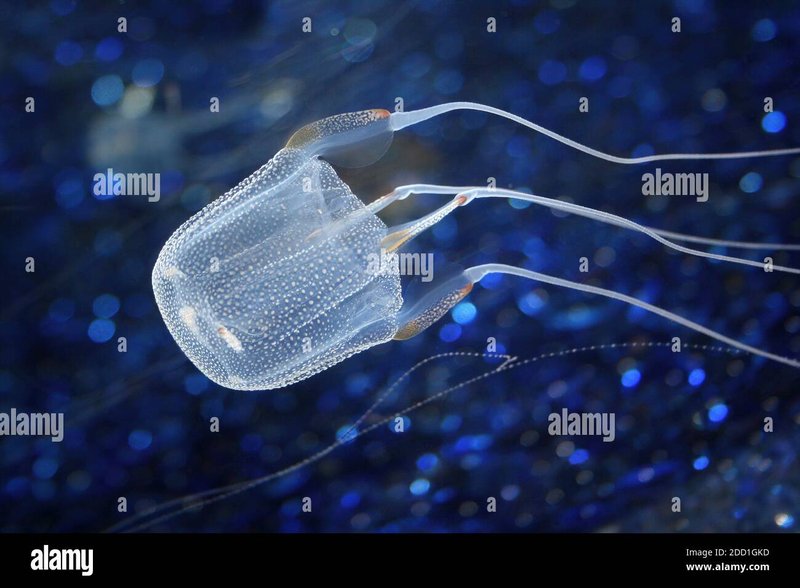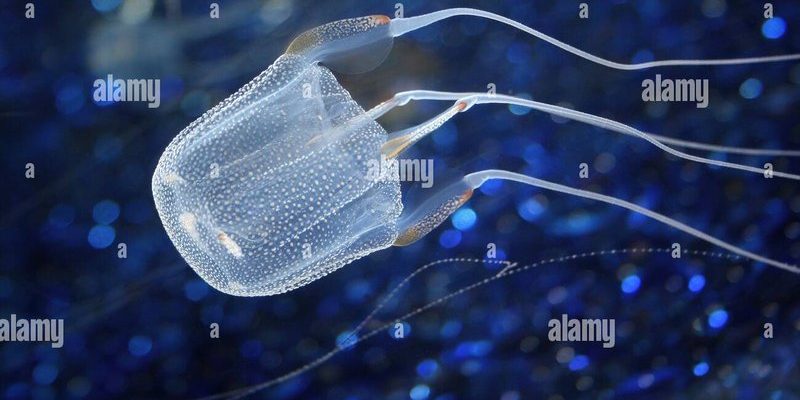
When you think about navigation, you might picture sailors with maps or even the latest GPS technology. The box jellyfish, however, navigates through a combination of instincts and specialized features. It relies on its environment and an intricate network of nerves to make decisions about movement and direction. It’s like a living compass, but instead of pointing north, it’s finely tuned to the ocean’s currents and its own needs.
So, how does this jellyfish do it? Grab your coffee, and let’s explore the incredible world of the box jellyfish and its unique navigation and communication methods.
The Unique Structure of the Box Jellyfish
Box jellyfish are easily recognized by their cube-like shape and long, trailing tentacles. Think of them as the sports cars of the jellyfish world—streamlined and built for agility. A key part of their structure is their sensory organs, known as rhopalia, located around the edges of their bell. These organs help them gather information from their surroundings.
Inside each rhopalium, box jellyfish have eyes—yes, eyes! They don’t see in the same way we do, but they can detect light and movement. This allows them to spot potential threats or navigate towards food. Imagine being able to sense light and shadow underwater without needing a flashlight; that’s the box jellyfish in action!
Moreover, their nervous system is quite fascinating. Unlike most creatures, they don’t have a centralized brain. Instead, they possess a decentralized nerve net that helps them respond to their environment. It’s as if their body is constantly working together in harmony to make quick decisions. This unique structure is part of what enables them to move with such grace in the water.
Swimming and Navigation Techniques
When it comes to swimming, box jellyfish are experts at gliding through the water. They use a method called pulsation to propel themselves forward. By contracting their bell, they push water behind them, which helps them move quickly. If you’ve ever watched a child bounce on a trampoline, you can picture how the jellyfish pops in and out of the water, propelling itself forward.
Box jellyfish can also make swift adjustments to their swimming direction. By detecting changes in the water currents, they can modify their movement to navigate around obstacles. This skill is especially important in the busy waters of coral reefs, where they need to avoid getting snagged. Imagine riding a bike and having the ability to instantly dodge an obstacle—this is how the jellyfish maneuvers through its environment.
Not only do they swim well, but box jellyfish can also travel long distances. They are known to cover vast areas in search of food or mates. Their ability to sense the currents and adjust their course accordingly gives them an edge in finding the best routes through the ocean.
Communication Among Box Jellyfish
You might think that jellyfish are solitary creatures, but communication plays a vital role in their lives. Box jellyfish communicate mainly through chemical signals released into the water. When they encounter other jellyfish, they can pick up on these chemicals, allowing them to understand each other’s presence.
This chemical communication is crucial during mating season. Box jellyfish use specific pheromones to signal their readiness to reproduce. It’s like sending out an invitation to everyone nearby, saying, “Hey, I’m looking to mate!” This method is highly effective, helping them find partners in the vast ocean.
Interestingly, scientists believe that box jellyfish may also communicate through light signals emitted by bioluminescence. When they feel threatened, some jellyfish can emit a glow that communicates danger to others nearby. Imagine a starry night where every flicker of light signals something important; that’s how these jellyfish might share information with one another.
How Box Jellyfish Sense Their Environment
Aside from their eyes and chemical signals, box jellyfish rely on a unique sense called mechanoreception. This allows them to detect vibrations and pressure changes in the water. It’s like having super-sensitive ears that can pick up on the tiniest movements around them.
When a fish swims nearby or a current shifts, the jellyfish can feel it. This helps them to adjust their swimming and avoid predators. Picture yourself walking with your eyes closed yet still managing to dodge every obstacle in your path—that’s how finely tuned a box jellyfish is to its surroundings.
These sensory adaptations are crucial for survival, especially since box jellyfish are often found in busy environments like coral reefs. Being able to sense and react to changes in their surroundings can mean the difference between safety and becoming a meal for a larger predator.
The Role of Current and Environment in Navigation
The box jellyfish’s environment plays a significant role in how it navigates. Ocean currents can greatly affect where these creatures end up. They have adapted to using currents to their advantage, allowing them to travel greater distances without expending too much energy.
Think of it as catching a ride on a bus rather than walking to your destination. Box jellyfish can position themselves strategically in the water to leverage these currents to their benefit. This not only helps them conserve energy but also aids in finding food sources more effectively.
In their natural habitats, like tropical and subtropical waters, box jellyfish can sometimes be found in nutrient-rich areas. These regions often attract smaller fish and plankton, which are essential food sources. By understanding their environment and using it to navigate, box jellyfish can thrive in their underwater world.
Threats and Adaptations
Despite their fascinating abilities, box jellyfish face various threats in their environment. Predators like turtles and larger fish see jellyfish as a meal, and environmental changes can impact their populations. However, they have evolved some remarkable adaptations that help them survive.
One significant defense mechanism is their stinging tentacles. When threatened, box jellyfish can use their tentacles to deliver painful stings to potential predators. It’s like having a built-in security system that protects them from harm. The venom they produce is potent and acts as both a defense and a way to capture prey.
Moreover, their transparent bodies serve as a form of camouflage. In the murky waters of their habitat, they can blend in with the surroundings. Imagine wearing a clear raincoat on a foggy day; it makes it harder for others to spot you. This transparency allows box jellyfish to navigate through their environment while staying safe from predators.
The Future of Box Jellyfish Navigation and Research
As scientists continue to study the box jellyfish and its navigation skills, new discoveries emerge that deepen our understanding of this incredible creature. The way they navigate and communicate offers insights into evolution and adaptability in the marine world.
Researchers are particularly interested in their sensory systems, as understanding how box jellyfish react to their environment could lead to advancements in marine biology and technology. Imagine using principles learned from these jellyfish to enhance underwater robotics or improve navigation systems. The possibilities are endless!
In recent years, discussions around climate change and its impacts on ocean life have become increasingly important. Box jellyfish populations might also be affected by changing sea temperatures and pollution. Understanding their navigation and communication could help in conservation efforts, ensuring that these fascinating creatures continue to thrive in our oceans.
In summary, the box jellyfish isn’t just a beautiful swimmer; it’s a master navigator and communicator. From using its unique sensory structures to navigating the ocean currents, this jellyfish embodies adaptability in a constantly changing environment. As we learn more about these creatures, we can appreciate the intricate ways they engage with the world around them. So, next time you see a jellyfish, remember there’s a lot more going on beneath the surface!

